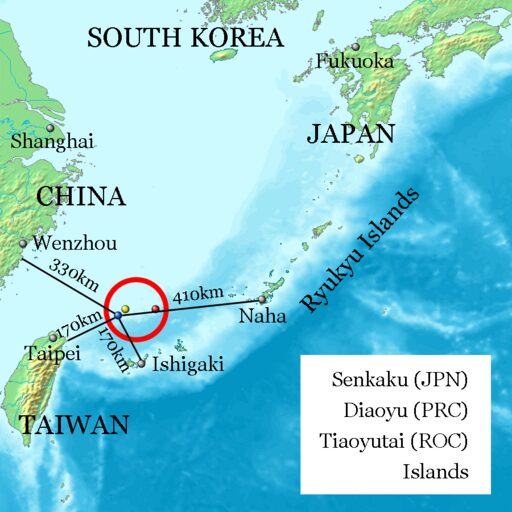Senkaku Islands

The Senkaku Islands is a group of islands located north-northwest of Yaeyama, including Uotsuri Island, Kitakojima, Kuba Island, Taishō Island, etc. The total area is 6.3 km2, which is a little less than Lake Yamanaka near Mt. Fuji. The biggest among them is Uotsuri Island, which used to have some katsuobushi (dried bonito) factories and Japanese inhabitants; it scarcely has any flat land and is unsuitable for human residency, hence is deserted currently.
However, since 1968 when the possibility of petroleum resources buried in the continental shelf around the islands was pointed out, many began to show interest all of a sudden.
The Taiwanese government claimed its dominium in April 1971, as well as the People’s Republic of China government which officially declared in December 1971 that the islands belonged to them. The Japanese government, on the basis of the transitions as the Reversion of Okinawa which occurred in May 1972, also insisted that they belonged to Ishigaki City, Okinawa, and hence a part of Japan. Thus, these so-called “border islands” could be a trigger at any time; they were visited once in a while by some Japanese who aimed to hoist a national flag, or by Taiwanese or Chinese people for their protest, causing sporadic troubles with the Japan Coast Guards.

Wikimedia Commons
There are various viewpoints on “inherent territory.” For example, the Chinese envoys Sappōshi to the Ryukyu Kingdom appear to have taken the following route: the ships left the port of Foochow, passed by the Senkaku Islands, stopped at Kume Island, and finally arrived at Naha Port. It is reported in a logbook that “the sight of the Kume Island meant we were in Ryukyu territory.” The question is, how do we interpret this? While it could be understood that if the Ryukyu territory starts from Kume Island, then the territory until then belongs to China; on the other hand, we can interpret that since there is no mention of the Senkaku Islands, no country owned them. And thus, given that later there were Japanese residents, they could belong to Japan. Nevertheless, there is also a Chinese viewpoint that considers “Ryukyu” not part of Japan. I just hope that Japan, Taiwan, and China get along with each other.








































































































































































































































